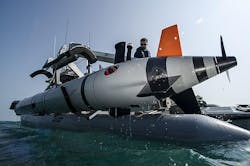Navy eyes unmanned underwater vehicle (UUV) weapons payloads to stop or disable 160-foot ships at sea
NEWPORT, R.I. – U.S. Navy unmanned underwater vehicle (UUV) experts are surveying industry for enabling technologies for future UUVs to stop or disable large ocean-going vessels as long as 160 feet. Experts are interested in lethal or non-lethal UUV weapons payloads, as well as ways to speed UUVs accurately to their targets.
Officials of the Naval Undersea Warfare Center Division Newport (NUWCDIVNPT) in Newport, R.I., issued a request for information this week (N66604-18-R-2397) for explosive or non-explosive technologies that could enable a UUV to stop or disable boats and ships shorter than 50 meters long (164 feet).
For reference, a 50-meter vessel is roughly as long as a medium-sized luxury yacht, or a U.S. Coast Guard Sentinel-class fast-response cutter. This RFI is to gather information on best practices, technology solutions, and cost estimates for UUV modular lethal or non-lethal weapons payloads and enhancements.
The Navy's request for information is to help experts understand market availability, technical characteristics, cost, and functionality of information technology (IT) tools, applications, or products for enabling UUVs to stop or disable 50-meter vessels, and to provide the Navy with an asymmetrical warfare advantage during UUV operations in complex, shallow-water, and cluttered littoral environments.
Related: Russian unmanned underwater nuclear weapon raising the stakes in global balance of power
The idea is to detect, understand, and react to threats in this environment that pose significant risk to the warfighter and other military assets. Officials of the Naval Surface Warfare Center Indian Head EOD Technology Division (NSWCIHEODTD) in Indian Head, Md., also will use information provided from industry.
The project has two objectives: to investigate UUV effector payloads for UUVs can stop or disable maritime vessels of less than 50 meters in length; and investigate technologies to give UUVs the speed and navigational precision to deliver effector payloads to stop or disable ocean vessels.
The first objective is to investigate UUV effector payloads that can be integrated into, deployed from or attached to a UUV to help it stop or disable maritime vessels shorter than 50 meters. The means of disablement may be kinetic or non-kinetic and the effect may be lethal or non-lethal.
The effector payload must be able to be transported and deployed from an UUV or be part of the UUV itself. Navy researchers want the maximum effect from the smallest possible UUV.
Related: Military research projects may be coming together to put large long-endurance UUVs in sight
The second objective is to investigate commercial or developmental UUV capability enhancements that will result in increased UUV speed and positional and placement accuracy to deliver the effector payload. Industry white papers may address one or both objectives.
Companies interested should email responses no later than 31 Aug. 2018 to the Navy's Christopher Patty at [email protected]. Email questions or concerns to the Navy's Gregory Harris at [email protected].
More information is online at https://www.fbo.gov/spg/DON/NAVSEA/N66604/N66604-18-R-2397/listing.html.
Ready to make a purchase? Search the Military & Aerospace Electronics Buyer's Guide for companies, new products, press releases, and videos

